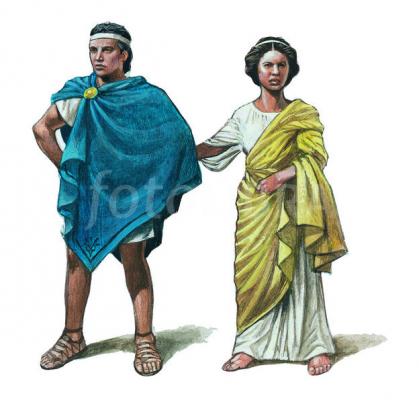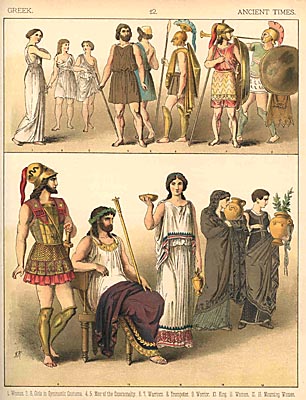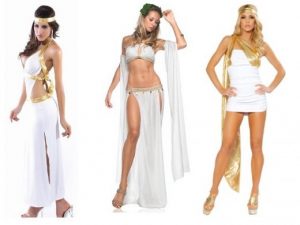Ancient Greece Clothes were elegant and very voluminous. They were most often made of fine woolens. They were mostly white with the only colors being dyed from plants or insects and they were uncut and were not even sewed as they mostly used a rectangular cloth for draping around themselves.
The making of clothing in Ancient Greece was considered to be a sphere of women, especially from the archaic age onwards, as housewives were given the duty to make clothes for the family. There were many women selling the clothes spun by them. Sometimes the prostitutes sold their spun wool to get an extra source of income, although the garment trade was conducted mainly the male merchants.

Mycenean and Minoan dressing
The Minoans were mainly a simple loincloth with a cloak. Some wore footwear, but most often, especially indoors, did wear footwear but on most times especially indoors people preferred to walk barefoot.
Their clothing was bright with colours like red, yellow, black and purple were used.
The athletes in many cases went naked or just wore a loincloth while women wore bell shaped and their upper portion and breasts were exposed, being covered by just jewelry.
The Mycenaen women too wore bell shaped skirts with bare beats. Men wore the same loincloth but a different headpiece. While warriors wore their more widely known chiton tunic for the first time in Mycenaean Greece along with helmets, knee length boots and kilts.
Archaic and Classical clothing
After the so called ‘ Dark Ages’, civilizations began to revive in the Archaic and its fashion also underwent a significant change from the Mycenaean and Minoan periods.
The garments were made mainly of wool and linen. The coarse woolen cloth was mainly for the poor while linen was available to the rich, who even decorated their garments with colourful dyes which were decorated by prints and weights which made them drape across the body and also held them securely.
The wealthy preferred brightly coloured borders on their clothes with the colour purple very popular. The length of the clothing depended upon the genders with the women wearing clothes up the ankles while men preferred clothing up to their knees.
There were four main clothes used by the Ancient Greeks:
Chitons
The sleeves of the robe were designed in such a way, that they allowed the arms to flow freely. This robe was worn by both sexes. Two different styles of chiton were developed: the Ionic chiton and the Doric chiton, with variations, usually of length, to distinguish styles for men and women. The fabric of chitons was crinkled, or pleated, to enhance the fullness of the drape of the garment. Older men also often are depicted wearing long draped mantles either alone or over a chiton.
Women’s Chitons were draped in a variety of ways and were also worn with mantles. Greek fabric included complex border designs both woven in and embroidered.The tunic, also wore generally were two rectangular pieces of cloth interwoven together. Some costumes worn by the ancient Greeks also had buttons made from bone.

Chalmys
Himation
Another type of cloak used by Greek generals, kings, queens and nobles was the Himatan which could be used as a cloak or a robe or even a blanket. It was mainly used to shield themselves against the cold Greek winters, being made of thick wool
Peplos
Some women wore a large square piece of cloth known as Peplos instead of chiton. In many cases, upper class women wide a chiton as an undergarment with an ornamented Peplos over it.
It was made of wool and could be classed at the shoulders. It was quite light and often pleated which was made of linen and could be worn by both genders.
Apart, from this clothes’ women also had to wear the Perizoma, or an underwear and a strophion, or a bra. An ornamented shawl was also sometimes used by the women during the winters known as the Epiblema.
Cloaks were wrapped in different styles around the body. The colors most commonly used by the ancient Greeks were grey and violet. White was a color that was used in some traditions. Pins and brooches were used to hold the clothing together. Petasos, a kind of headgear similar to a hat, was preferred by the men in ancient Greece.
The Greeks also wore a wide brimmed hat to protect themselves from the heat known as the Petasos. Women on the other hand used hats with a high peaked crown.

Ancien Greek wedding Dresses
Wedding dresses were also a significant part of ancient Greek culture. The elegant gowns that were used in weddings were known for their simplicity. Even today, gowns worn at weddings are influenced by ancient Greek designs.
The wealthiest Greeks could afford fine wool and finely woven linen, which at its most expensive was an almost transparent, soft cloth. Others used cloth woven from the flax plant soaked in olive oil, and peasants used textiles made of coarse wool.

Footwear
The Ancient Greeks sometimes wore sandals, slippers, shoes and even boats. Philosophers like Socrates were famous for their chiton wearing looks and with basic leather shoes.
Soldiers also had to be supplied boosts and sandals which were provided with shin protectors known as graves. But many still prefer going barefoot, as famous athletes rejected footwear and performed with footwear.
The ancient Greeks also did not ever wear shoes inside their house. Going outside with a pair of shoes was a symbol of wealth but most people preferred to be barefooted inside their homes.
Ancient Greek Costumes
Ancient Greece Clothes and costumes were very colorful and many dyed their clothes. Wealthy aristocrats wore purple clothes dyed from a species of shellfish or pure white linen robes. Yellow clothes were worn mostly by women.
Black clothes were worn by those mourning the death of a loved one. Peasants dyed their clothing a variety of greens, browns, and greys. Soldiers wore dark red garments to minimize the appearance of blood on the battlefield.
In addition to dying, decorative designs were also painted, embroidered, or woven onto garments in many colors. Garments were also adorned with patterns of geometric shapes or trimmed with colorful border designs.In different phases of Greek history, the simplicity and attire of Greek costumes have remained the same.